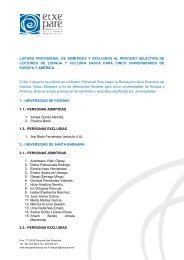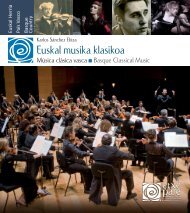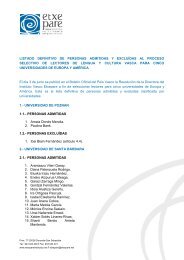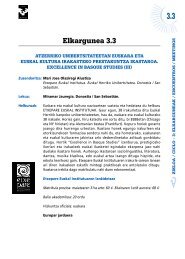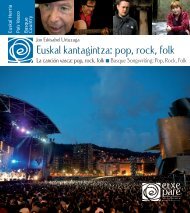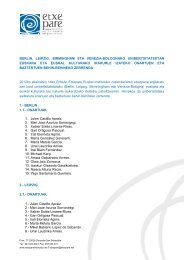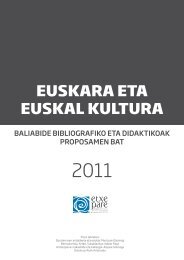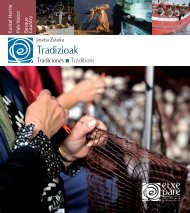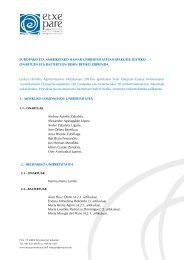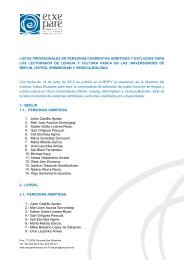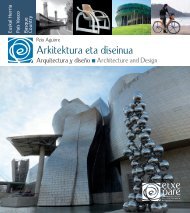Euskal dantza - Etxepare, Euskal Institutua
Euskal dantza - Etxepare, Euskal Institutua
Euskal dantza - Etxepare, Euskal Institutua
Create successful ePaper yourself
Turn your PDF publications into a flip-book with our unique Google optimized e-Paper software.
zas, como los que se bailan en el alarde del moro deAntzuola o en las danzas de San Juan de Berastegi. Enla Rioja Alavesa, en Elciego y en Laguardia por ejemplo,se bailan danzas de paloteo y, hasta el siglo XX,también se bailaron en Villabuena y en Oyón.Soka-<strong>dantza</strong>k (danzas en cadena)Es habitual que al finalizar las danzas de espadas olas danzas de troqueo, se baile el aurresku o la danzaen cadena. Pero no siempre acompañan a las danzasde troqueo, a menudo se bailan solas. Estas esku<strong>dantza</strong>so danzas de manos, habituales en los bailesabiertos y romerías de antaño, se nos presentanritualizadas hoy en día. Según el sio, a la danza decuerda se le da el nombre de aurresku, <strong>dantza</strong>-soka,gizon-<strong>dantza</strong>, karrika-<strong>dantza</strong> o esku-<strong>dantza</strong>, entreotros. Los ingurutxoak son el equivalente de las danzasde cuerda de la verente mediterránea y se bailanpor parejas, en círculo abierto.En la soka-<strong>dantza</strong>, los bailarines conforman una cuerdadándose las manos para salir a la plaza girandoen el sendo contrario a las agujas del reloj. El bailarínque encabeza la cuerda, denominado aurresku(primera mano o mano de delante) ene una importanciaespecial en la danza de cuerda. En el otro extremode la cadena va el atzesku (mano de atrás),en úlma posición. Entre los dos dirigen las evolucionesdel grupo y son los que realizan las principalesdemostraciones de virtuosismo a lo largo del baile.De hecho, esas mismas danzas que el aurresku bailadentro de la soka-<strong>dantza</strong> son las que, sacadas de contexto,se bailan a parr del úlmo tercio del siglo XXen eventos, homenajes, protocolos, inauguracionesy eventos de todo po.Aunque hoy en día el aurresku se conozca comodemostración individual de honor, la soka-<strong>dantza</strong>ha mantenido su carácter colecvo. La guían y bailanprincipalmente los solistas, pero es el conjuntoel que llena de significado la danza. El grupo de bailarinesque entra de la mano en la plaza transmitetzak dances in Berastegi. In the Rioja region of Araba,the trokeo-<strong>dantza</strong>k are sll performed in Eltziego andGuardia, and they were performed in Villabuena andOion unl the tweneth century.Soka-<strong>dantza</strong>kAt the end of an ezpata-<strong>dantza</strong> or trokeo-<strong>dantza</strong>performance, it is commonplace to perform the aurreskua or soka-<strong>dantza</strong>. The laer is also oen performedwithout the other dances. At one me, thesoka-<strong>dantza</strong>k, which we see today in their ritualisedform, were typical during open-air and free dances.The soka-<strong>dantza</strong> goes by several names: aurreskua,<strong>dantza</strong>-soka, gizon-<strong>dantza</strong> (male dance), karrika<strong>dantza</strong> (street dance), esku-<strong>dantza</strong> (hand dance),erregelak (the rules), as well as several other localnames. There are equivalents to the soka-<strong>dantza</strong>kin the tradional round or circular dances of theMediterranean slopes –open circle dances that aredanced by pairs.In the soka-<strong>dantza</strong>k the dancers form a chain orrope by holding hands with one another and this ishow they enter the square or public area where theperformance takes place, moving round and roundanclockwise. The dancer at the head of the ropeor chain, termed the aurreskua or aurre (forefront,first) eskua (hand), is especially important in thesoka-<strong>dantza</strong>. At the other end of the rope or chain,in last pace, is the atzeskua (the last hand). The twoof them direct the group’s movements, and the aurreskuaand atzeskua perform most of the solo dancesin the suite. Indeed, the dances performed by theaurreskua in the soka-<strong>dantza</strong> were taken out of theiroriginal context, and from the late tweneth centuryonwards, became commonplace dances at differentkinds of ceremonies, tributes, protocols, welcomesand inauguraons.Although the aurreskua has become a typical individualpresentaon, the soka-<strong>dantza</strong>k have maintainedtheir collecve nature. Solo performers mainly lead37



